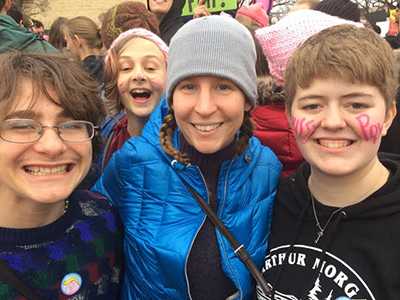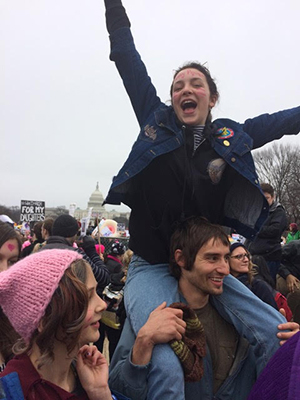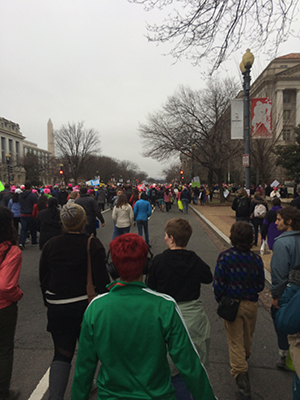Why is Student Led Activism Important to Middle Schoolers?

If the March for Our Lives rally demonstrates anything, it’s that adolescents are eager to get involved. With estimates of over 200,000 attendees in D.C. alone and countless other demonstrations across the country, it’s apparent that teenagers are excited to voice their concerns about world events. Montessori describe 12-15 year olds as “…naturally drawn to causes that involve high ideals. They prefer to take on projects that require action and they believe they can make a positive difference in the world.” Student led activism, whether it be marches, demonstrations, or simple letter writing campaigns make the perfect outlets for these rising urges.
The idea of young people standing up for what they believe is not a new concept. The New York Times recently highlighted seven social justice movements in just the last 60 years in which students played a major role. They include among them the Civil Rights Movement, Vietnam protests, and Black Lives Matter. However there are also historical references of children marching for workers’ rights as far back as the 19th century. Young adolescents want to make their political opinions heard. As teachers we can give them the confidence to do so.
Finding their Voice
 Middle school can be a confusing time when it comes to navigating social issues. As they learn the historical context for our world’s problems, they soon realize problems are more complex and harder to solve. They struggle with their own sense of morality as they weigh the many differing opinions. Adolescents don’t always feel comfortable asking adults for answers. As a result, they feel stuck and sometimes lose their momentum to get involved.
Middle school can be a confusing time when it comes to navigating social issues. As they learn the historical context for our world’s problems, they soon realize problems are more complex and harder to solve. They struggle with their own sense of morality as they weigh the many differing opinions. Adolescents don’t always feel comfortable asking adults for answers. As a result, they feel stuck and sometimes lose their momentum to get involved.
Many teachers and parents want to support their students’ passion to participate politically. That is evident by the number of educators and families who turned out to support the Marjory Stoneman Douglas students that organized March for Our Lives. What tools can they use to help students understand their political views and the confidence to articulate them?
Cultivating a Student Led Activism Mindset
At Arthur Morgan School, staff support students who want to get involved. They create a safe learning environment that encourages questions and dialogue about tough social issues. They are careful not to push social agendas on their students. Instead, they follow where students lead them helping middle schoolers find their own answers to difficult social questions. By asking questions, the staff help students figure out their personal stances on issues. Then they provide opportunities to get involved.
Last year, when students heard about the Women’s March on D.C., our students wanted to participate. The staff made that possible by changing the school schedule last minute to accommodate the trip. Students and staff piled into vans and drove 10 hours to be part of the historical event. This year, the school’s 18 day field trips facilitated student involvement in the Black Lives Matter movement by attending trainings by BLM activists. Students also participated in the climate change debate by meeting with government officials. The students cherished these opportunities to create change for their future. They were also inspired to keep getting involved.
Using their Voice to Support Others
 The March for Our Lives rally might seem like a unusual cause for AMS students. With school policies that forbid any weapons (and even gun facsimiles) and a mostly outdoor campus that needs no metal detectors, gun control might seem a distant worry for AMS students. However, some students were still compelled to join the march. The event occurred while the school was on spring break, but that did not stop several students from attending their local events.
The March for Our Lives rally might seem like a unusual cause for AMS students. With school policies that forbid any weapons (and even gun facsimiles) and a mostly outdoor campus that needs no metal detectors, gun control might seem a distant worry for AMS students. However, some students were still compelled to join the march. The event occurred while the school was on spring break, but that did not stop several students from attending their local events.
Rey, a ninth grader who attended the Cincinnati rally, stated she felt going to the march was important. “I could have sat at home. It would have been warmer and more comfortable, but I wanted to support the people who were fighting to feel safe. I wanted to support the victims and their families. Ruth, another ninth grader, also attended the march in Indianapolis. She admitted she doesn’t worry about gun violence at AMS, but it still felt an important issue to support.
Middle schoolers want to get involved. They want to know about what’s happening in the world and how they can be part of making it a better place. By providing spaces for them to figure out their opinions and opportunities to get involved, teachers help them develop the confidence they need to seek out their personal causes. Through support and encouragement, teachers help students feel like they make a difference and inspire more student led activism for the future.
-by Nicholas Maldonado
